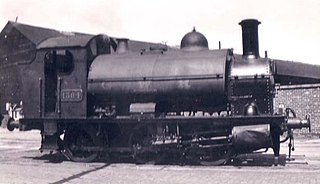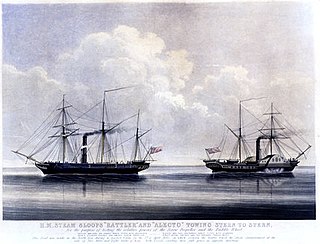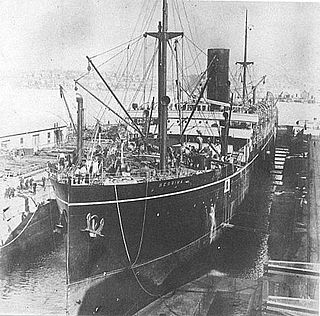
A propeller is a device with a rotating hub and radiating blades that are set at a pitch to form a helical spiral which, when rotated, exerts linear thrust upon a working fluid such as water or air. Propellers are used to pump fluid through a pipe or duct, or to create thrust to propel a boat through water or an aircraft through air. The blades are specially shaped so that their rotational motion through the fluid causes a pressure difference between the two surfaces of the blade by Bernoulli's principle which exerts force on the fluid. Most marine propellers are screw propellers with helical blades rotating on a propeller shaft with an approximately horizontal axis.

A steamship, often referred to as a steamer, is a type of steam-powered vessel, typically ocean-faring and seaworthy, that is propelled by one or more steam engines that typically move (turn) propellers or paddlewheels. The first steamships came into practical usage during the early 1800s; however, there were exceptions that came before. Steamships usually use the prefix designations of "PS" for paddle steamer or "SS" for screw steamer. As paddle steamers became less common, "SS" is assumed by many to stand for "steamship". Ships powered by internal combustion engines use a prefix such as "MV" for motor vessel, so it is not correct to use "SS" for most modern vessels.

Steam frigates and the smaller steam corvettes, steam sloops, steam gunboats and steam schooners, were steam-powered warships that were not meant to stand in the line of battle. There were some exceptions like for example the French Napoléon class steam ship of the line was meant to stand in the line of battle, making it the world's first steam battleship. The first such ships were paddle steamers. Later on the invention of screw propulsion enabled construction of steam-powered versions of the traditional ships of the line, frigates, corvettes, sloops and gunboats.

The British Rail Class 07 diesel locomotive is an off-centre cab 0-6-0 diesel-electric shunter type built by Ruston & Hornsby in 1962 for the Southern Region of British Railways. The 14 members of the class were primarily used at Southampton Docks and later also at Eastleigh Works.

Sentinel Waggon Works Ltd was a British company based in Shrewsbury, Shropshire that made steam-powered lorries, railway locomotives, and later, diesel engined lorries, buses and locomotives.

The 1361 Class were small 0-6-0ST steam locomotives built by the Great Western Railway at their Swindon railway works, England, mainly for shunting in docks and other sidings where track curvature was too tight for large locomotives.

Jones, Turner and Evans was a locomotive manufacturer in Newton-le-Willows, England from 1837, known as Jones and Potts between 1844 and 1852.

A & J Inglis, Ltd, was a shipbuilding firm founded by Anthony Inglis and his brother John, engineers and shipbuilders in Glasgow, Scotland in 1862. The firm built over 500 ships in a period of just over 100 years. Their Pointhouse Shipyard was at the confluence of the rivers Clyde and Kelvin. They constructed a wide range of ships, including Clyde steamers, paddle steamers and small ocean liners. In wartime, they built small warships, and in the period after World War II, they built a number of whalers.

HMS Rattler was a 9-gun steam screw sloop of the Royal Navy, and one of the first British warships to be completed with screw propulsion. She was originally ordered as a paddle wheel 4-gun steam vessel from Sheerness Dockyard on 12 March 1841. She was reordered on 24 February 1842 as a propeller type 9-gun sloop from HM Royal Dockyard, Sheerness, as a new vessel. William Symonds had redesigned the ship as a screw propeller driven vessel.
The North Eastern Railway (NER) Class K classified as Class Y8 by the London and North Eastern Railway (LNER) is a class of 0-4-0T steam locomotives designed for shunting. It was designed by Thomas W. Worsdell and five of these tiny engines were built in 1890. These were numbered 559-63.

A nutating disc engine is an internal combustion engine comprising fundamentally of one moving part and a direct drive onto the crankshaft. Initially patented in 1993, it differs from earlier internal combustion engines in a number of ways and uses a circular rocking or wobbling nutating motion, drawing heavily from similar steam-powered engines developed in the 19th century, and similar to the motion of the non-rotating portion of a swash plate on a swash plate engine.

SS Archimedes was a steamship built in Britain in 1839. She was the world's first steamship to be driven successfully by a screw propeller.

A screw steamer or screw steamship is an old term for a steamship or steamboat powered by a steam engine, using one or more propellers to propel it through the water. Such a ship was also known as an "iron screw steam ship".

HMS Niger was originally slated to be built as a Sampson designed sloop; however, she was ordered as a First-Class sloop with screw propulsion on 20 February 1845 to be built at Woolwich Dockyard, along the design developed by Oliver Lang and with a hull like the Basilisk designed paddle sloops. Her armament and engine were to be like the Encounter Design building at Pembroke. A second vessel (Florentia) was ordered on 26 March 1846 but after her keel was laid at Pembroke Dockyard, her construction was suspended on 6 October 1846 then cancelled three years later, on 22 May 1849. Niger She conducted important propulsion trials, finally proving the superiority of screw propulsion and served in West Africa, the Crimea, China, the East Indies and Australia. She took part in the New Zealand wars in 1860 and was sold for breaking in 1869.

TS King Edward was an excursion steamer built at Dumbarton for service down the River Clyde to the Firth of Clyde and associated sea lochs on the west coast of Scotland, as far as Campbeltown. The first commercial vessel to be driven by steam turbines, King Edward was remarkably successful for a prototype, serving as a Clyde steamer for half a century from 1901 until 1951, interrupted only by service in the two world wars. The success of the vessel quickly led to the adoption of turbine propulsion for all manner of merchant vessels, from channel ferries and coastal steamers to transatlantic liners.

Caird & Company was a Scottish shipbuilding and engineering firm based in Greenock. The company was established in 1828 by John Caird when he received an order to re-engine Clyde paddle-tugs.

HMS Phoenix was a 6-gun steam paddle vessel of the Royal Navy, built in a dry dock at Chatham in 1832. She was reclassified as a second-class paddle sloop before being rebuilt as a 10-gun screw sloop in 1844–45. She was fitted as an Arctic storeship in 1851 and sold for breaking in 1864.

SS Empress Queen was a steel-hulled paddle steamer, the last of her type ordered by the Isle of Man Steam Packet Company. The Admiralty chartered her in 1915 as a troop ship until she ran aground off Bembridge, Isle of Wight, England in 1916 and was abandoned.
John Penn and Sons was an English engineering company based in London, and mainly known for its marine steam engines.
Humphrys, Tennant and Dykes was a British engineering company based in Deptford, London, England.


















